Growing a Venus flytrap can be a rewarding experience, but success hinges on providing the right environment, starting with the soil. Unlike typical houseplants, Venus flytraps thrive in nutrient-poor soil. Using the wrong type can be detrimental, even fatal, to these fascinating carnivorous plants. This guide will delve into the specifics of what kind of soil your Venus flytrap needs to flourish.
The Crucial Role of Nutrient-Poor Soil for Venus Flytraps
Venus flytraps are native to the nutrient-depleted bogs of North and South Carolina. In their natural habitat, they’ve adapted to obtain nutrients not from the soil, but by trapping and digesting insects. This evolutionary adaptation means their roots are sensitive to the rich minerals and fertilizers found in standard potting mixes.
Using regular potting soil or enriched soil is a common mistake that can quickly harm your Venus flytrap. The high concentration of nutrients can “burn” their delicate roots, leading to plant stress and, ultimately, death. Fertilizing Venus flytraps is generally discouraged for the same reason. While some expert growers might use extremely diluted foliar fertilizers sparingly, this is risky and not recommended for beginners. It’s best to let your Venus flytrap obtain its nutrients naturally by catching insects or by supplemental feeding with insects like mealworms.
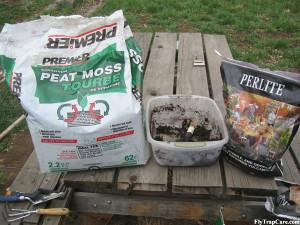 Peat Moss and Perlite
Peat Moss and Perlite
A close-up of a pre-mixed Venus flytrap soil blend, showcasing the light brown peat moss and white perlite components, ideal for carnivorous plants.
Essential Components of Venus Flytrap Soil
To mimic their natural bog environment, the ideal soil for Venus flytraps must be acidic, retain moisture, and provide excellent aeration. The best soil mixes typically consist of a combination of the following ingredients:
Peat Moss: The Foundation
Peat moss serves as the primary component in most Venus flytrap soil mixes. It is naturally acidic and excellent at retaining moisture while still allowing for some drainage. It’s crucial to use unfertilized peat moss. Avoid brands like Miracle-Gro or Scott’s peat moss, as these often contain added fertilizers that are harmful to Venus flytraps. Look for plain peat moss bales available at most garden centers.
Perlite: Enhancing Drainage and Aeration
Perlite is a lightweight, volcanic glass that resembles small white balls. When added to soil mixes, perlite improves drainage and aeration, preventing the soil from becoming waterlogged. This is vital for healthy root development in Venus flytraps. Perlite is readily available at most department stores, hardware stores, and nurseries. Horticultural sand or silica sand can sometimes be used as a substitute for perlite, but perlite is generally preferred for its superior aeration properties.
Silica Sand: Optional for Added Aeration
Silica sand, also known as horticultural sand, is a pure form of sand composed of silicon dioxide. It’s inert, meaning it doesn’t release minerals into the soil, making it safe for carnivorous plants. Silica sand further enhances soil aeration and contributes to a healthy root system. While not strictly necessary, incorporating silica sand into your Venus flytrap soil mix can be beneficial.
Long-Fiber Sphagnum Moss: A Pure Alternative
Long-fiber sphagnum moss is another excellent option, and can even be used as a standalone medium for growing Venus flytraps. Like peat moss, it is acidic and retains moisture. High-quality, New Zealand long-fiber sphagnum moss is particularly prized for its purity and water-holding capacity. It provides excellent aeration and is a natural and effective medium for Venus flytraps.
Recommended Venus Flytrap Soil Mixes
There are several effective soil mixes you can use for your Venus flytrap. Here are two popular options:
The Standard 1:1 Peat and Perlite Mix
The most widely used and recommended mix is a simple 1:1 ratio of peat moss and perlite by volume. This “standard CP (carnivorous plant) mix” is suitable for most carnivorous plants, including Venus flytraps. It’s easy to prepare and provides a good balance of moisture retention, drainage, and aeration. Many growers also like to top this mix with a layer of long-fiber sphagnum moss to prevent perlite from floating to the surface during watering.
The FlytrapStore Preferred 5:3:2 Mix
For an even more aerated mix, consider using the FlytrapStore’s preferred blend: 5 parts peat moss, 3 parts silica sand, and 2 parts perlite by volume. The addition of silica sand further improves aeration and promotes robust root growth. This mix is particularly beneficial in warmer climates or for growers who tend to overwater.
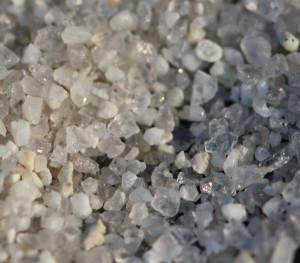 Silica Sand
Silica Sand
A pile of silica sand, highlighting its fine texture and light color, an optional component in Venus flytrap soil mixes for enhanced aeration.
How to Mix Venus Flytrap Soil
Mixing your own Venus flytrap soil is a straightforward process. Follow these steps:
-
Gather Your Materials: You’ll need peat moss, perlite (and optionally silica sand), distilled water, and a container for mixing, such as a five-gallon bucket.
-
Combine Dry Ingredients: Add the peat moss to the mixing container, followed by the perlite and silica sand (if using), in your desired ratio.
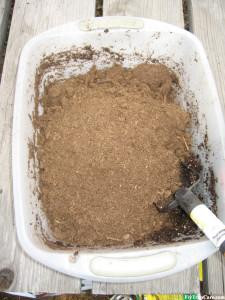 Add Peat Moss
Add Peat Moss Add Perlite
Add Perlite -
Moisten the Mix: Gradually add distilled, reverse osmosis, or rainwater to the dry ingredients. Peat moss can be hydrophobic when dry, so add water slowly and mix thoroughly.
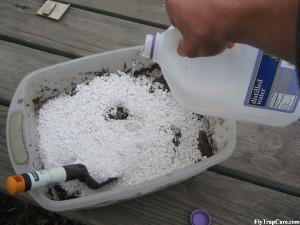 Add Distilled Water
Add Distilled Water -
Mix Thoroughly: Continue adding water and mixing until the peat moss is fully saturated and the perlite (and silica sand) are evenly distributed. The final mixture should be moist but not waterlogged, with a consistency similar to a wrung-out sponge.
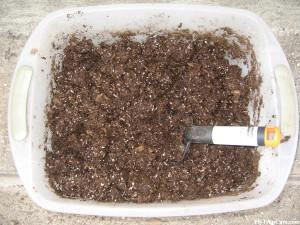 Standard Carnivorous Plant Soil Mix
Standard Carnivorous Plant Soil Mix
Choosing the Right Pot for Your Venus Flytrap
While soil is critical, the right pot also contributes to your Venus flytrap’s health. Opt for pots with good vertical depth, ideally 4-5 inches deep or more, to accommodate the roots as they grow downwards. Deeper pots are generally better.
Insulation is another important factor, especially in climates with temperature extremes. Insulated pots help maintain a more stable root temperature, protecting the roots from overheating in summer and freezing in winter.
Pot Material Options
- Plastic Pots: Inexpensive and readily available, plastic pots work, but dark-colored plastic can absorb heat and cause temperature fluctuations.
- Insulated Foam or Styrofoam Cups: These are excellent, budget-friendly options. White styrofoam reflects heat, and the insulation provides temperature stability for the roots. Choose cups that are at least 16 ounces for sufficient depth.
Repotting Considerations
Repotting is a necessary part of Venus flytrap care, typically done every 1-2 years to refresh the soil and provide more room for growth. When repotting, gently remove the plant from its old pot, carefully remove as much of the old soil as possible from the roots, and replant it in fresh, properly prepared Venus flytrap soil in a clean pot. Ensure the rhizome (the white bulb-like structure at the base of the plant) is just slightly below the soil surface.
By understanding the specific soil requirements of Venus flytraps and using the right components and techniques, you can create the perfect growing medium for these captivating carnivorous plants to thrive. Remember, nutrient-poor, acidic, and well-aerated soil is the key to a healthy and vigorous Venus flytrap.